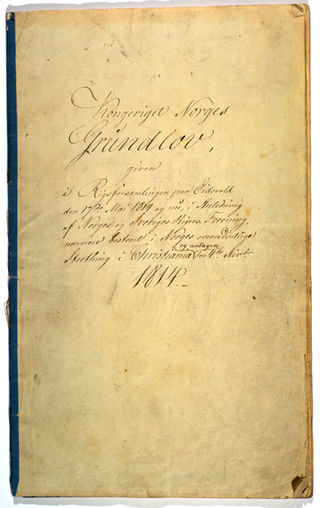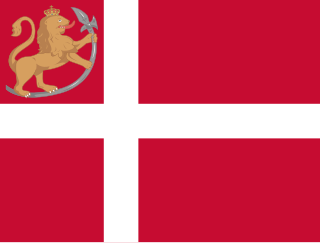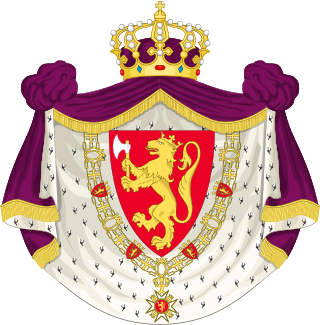
The Kalmar Union was a personal union in Scandinavia, agreed at Kalmar in Sweden as designed by widowed Queen Margaret of Norway and Sweden. From 1397 to 1523, it joined under a single monarch the three kingdoms of Denmark, Sweden, and Norway, together with Norway's overseas colonies.

The Constitution of Norway was adopted on 16 May and signed on 17 May 1814 by the Norwegian Constituent Assembly at Eidsvoll. The latter date is the National Day of Norway; it marks the establishment of the constitution.

Christian VIII was King of Denmark from 1839 to 1848 and, as Christian Frederick, King of Norway in 1814.

The monarchy of Sweden is centred on the monarchical head of state of Sweden, by law a constitutional and hereditary monarchy with a parliamentary system. There have been kings in what now is the Kingdom of Sweden for more than a millennium. Originally an elective monarchy, it became a hereditary monarchy in the 16th century during the reign of Gustav Vasa, though virtually all monarchs before that belonged to a limited and small number of political families which are considered to be the royal dynasties of Sweden.

Christian I(Christiern I) was a German noble and Scandinavian monarch under the Kalmar Union. He was king of Denmark (1448–1481), Norway (1450–1481) and Sweden (1457–1464). From 1460 to 1481, he was also duke of Schleswig and count of Holstein. He was the first king of the House of Oldenburg.

John was a Scandinavian monarch under the Kalmar Union. He was king of Denmark (1481–1513), Norway (1483–1513) and as John II Sweden (1497–1501). From 1482 to 1513, he was concurrently duke of Schleswig and Holstein in joint rule with his brother Frederick. As of 2024, he was the last Danish king whose regnal name was not "Frederik" or "Christian".
An heir apparent or simply heir is a person who is first in an order of succession and cannot be displaced from inheriting by the birth of another person. A person who is first in the current order of succession but could be displaced by the birth of a more eligible heir is known as heir presumptive.

Swedish pre-history ends around 800 AD, when the Viking Age begins and written sources are available. The Viking Age lasted until the mid-11th century. Scandinavia was formally Christianized by 1100 AD. The period 1050 to 1350—when the Black Death struck Europe—is considered the Older Middle Ages. The Kalmar Union between the Scandinavian countries was established in 1397 and lasted until King Gustav Vasa ended it upon seizing power during the Swedish War of Liberation, which concluded in 1523. The period from 1350 to 1523 is considered the Younger Middle Ages. During these centuries, Sweden gradually consolidated as a single nation.

Sweden and Norway or Sweden–Norway, officially the United Kingdoms of Sweden and Norway, and known as the United Kingdoms, was a personal union of the separate kingdoms of Sweden and Norway under a common monarch and common foreign policy that lasted from 1814 until its peaceful dissolution in 1905.
An elective monarchy is a monarchy ruled by a monarch who is elected, in contrast to a hereditary monarchy in which the office is automatically passed down as a family inheritance. The manner of election, the nature of candidate qualifications, and the electors vary from case to case. Historically, it was common for elective monarchies to transform into hereditary ones over time or for hereditary ones to acquire at least occasional elective aspects.

Magnus Haakonsson was King of Norway from 1263 to 1280. One of his greatest achievements was the modernisation and nationalisation of the Norwegian law-code, after which he is known as Magnus the Law-mender. He was the first Norwegian monarch known to have used an ordinal number, although originally counting himself as "IV".

In 1814, the Kingdom of Norway made a brief and ultimately unsuccessful attempt to regain its independence. While Norway had always legally been a separate kingdom, since the 16th century it had shared a monarch with Denmark; Norway was a subordinate partner in the combined state, whose government was based in Copenhagen. Due to its alliance with France during the Napoleonic Wars, Denmark was forced to sign the Treaty of Kiel in January 1814 ceding Norway to Sweden.
The Kingdom of Norway as a unified realm dates to the reign of King Harald I Fairhair in the 9th century. His efforts in unifying the petty kingdoms of Norway resulted in the first known Norwegian central government. The country, however, soon fragmented and was collected into one entity in the first half of the 11th century, and Norway has retained a monarchy since that time. Traditionally, it has been viewed as being ruled by the Fairhair dynasty, though modern scholars question whether the eleventh century kings and their successors were truly descendants of Harald.

Members of the Norwegian royal family are people related to King Harald V of Norway or former Norwegian monarchs. The current family who holds the throne are members of the House of Glücksburg who ascended to the Norwegian throne after the election of Prince Carl of Denmark as King of Norway during the dissolution of the Swedish-Norwegian union in 1905.

Eric Magnusson was a Swedish prince, Duke of Svealand, Södermanland, Dalsland, Västergötland, Värmland and North Halland and heir to the throne of Sweden. His son, Magnus, became king of Norway and Sweden.

The Norwegian monarch is the head of state of Norway, which is a constitutional and hereditary monarchy with a parliamentary system. The Norwegian monarchy can trace its line back to the reign of Harald Fairhair and the previous petty kingdoms which were united to form Norway; it has been in unions with both Sweden and Denmark for long periods.

The civil war era in Norway began in 1130 and ended in 1240. During this time in Norwegian history, some two dozen rival kings and pretenders waged wars to claim the throne.

The Sudreim claim was an entitlement to the throne of the Kingdom of Norway held among members of the powerful and influential House of Sudreim in the late Middle Ages.

A referendum on retaining the monarchy or becoming a republic was held in Norway on 12 and 13 November 1905. Voters were asked whether they approved of the Storting's decision to authorise the government to make the offer of the throne of the newly self-ruling country. The Storting had wanted to offer the throne to Prince Carl of Denmark, but the prince insisted that the Norwegian people have a chance to decide whether they wanted to retain a monarchy.

The monarchy of Denmark is a constitutional institution and a historic office of the Kingdom of Denmark. The Kingdom includes Denmark proper and the autonomous territories of the Faroe Islands and Greenland. The Kingdom of Denmark was already consolidated in the 8th century, whose rulers are consistently referred to in Frankish sources as "kings". Under the rule of King Gudfred in 804 the Kingdom may have included all the major provinces of medieval Denmark.